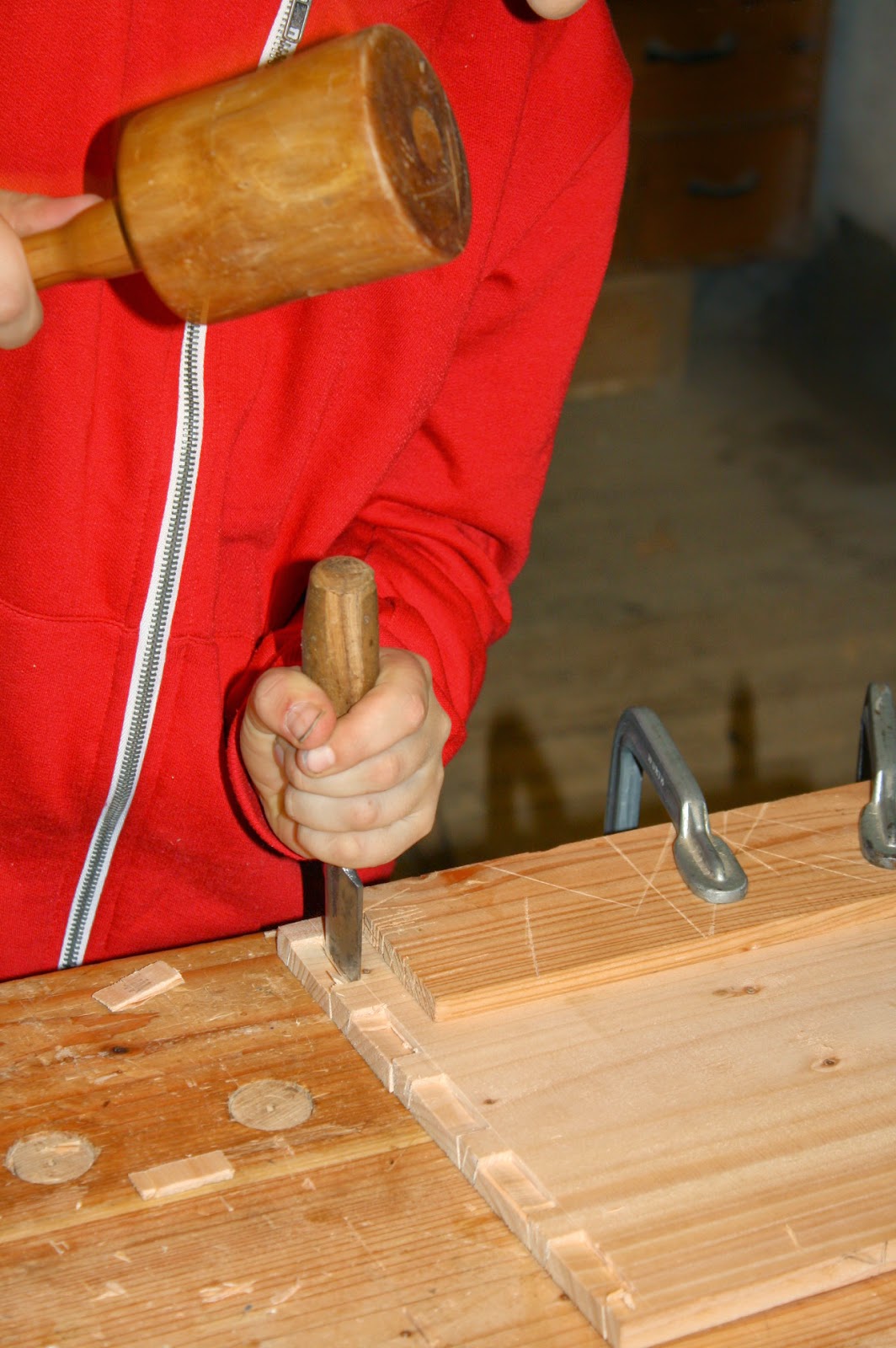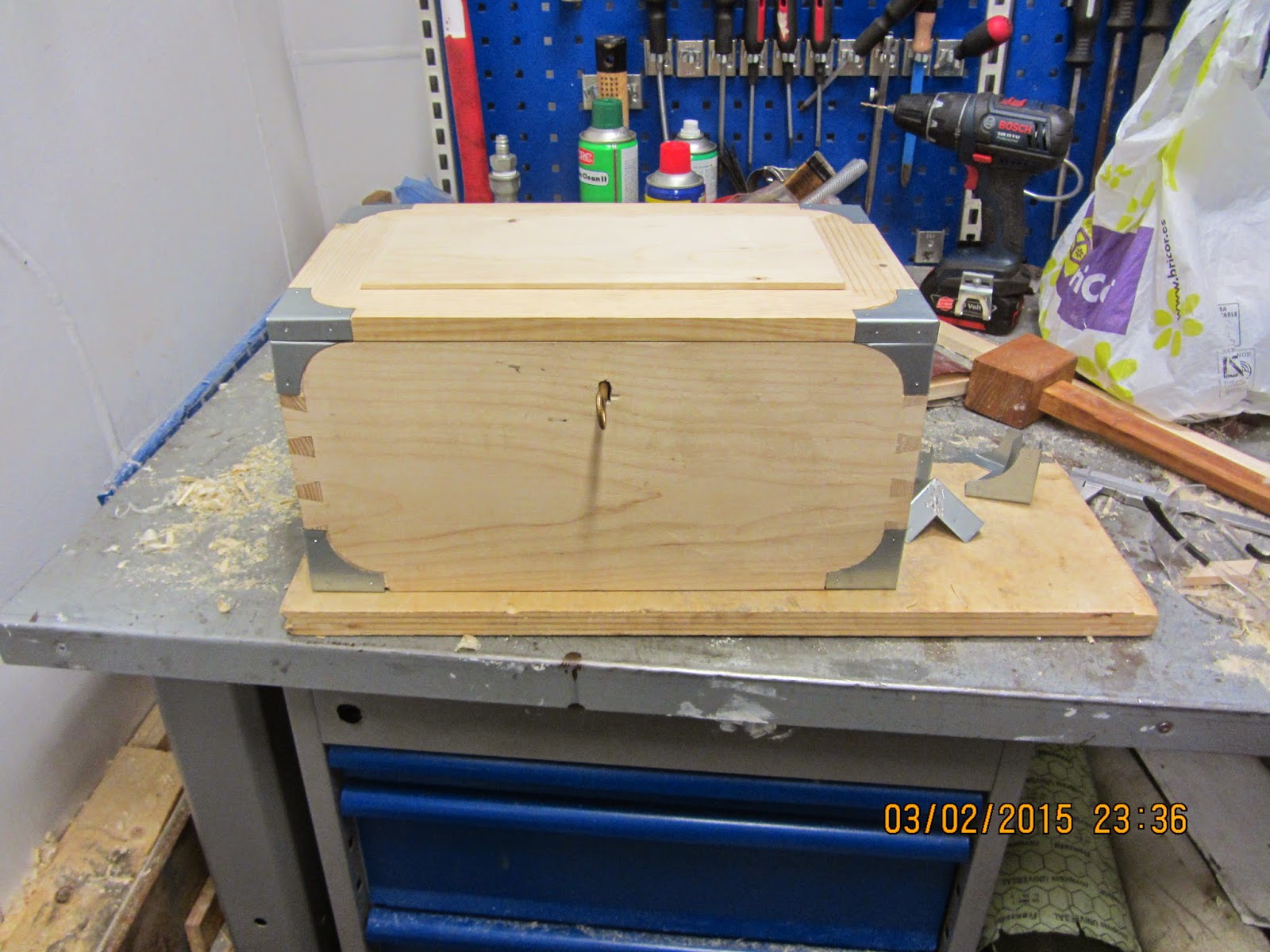The interior of the chest:
11 cm (4.5") above the bottom of the chest there are two small strips of wood running the entire length.
These strips hold the shooting board, so it acts a a divider between the lower part of the chest where I keep the planes, and the upper part where I have two tills.
To facilitate removal of the shooting board, I drilled a couple of 30 mm (1.25") holes in it. That way I can poke my fingers through the holes and lift it out of the chest.
Above the shooting board rests two shallow tills.
The height of the tills corresponds to the distance between the shooting board and the dust seal of the lid, when the lid is closed. I think that if I pace a thin piece of cardboard, I could probably turn the chest upside down without anything falling out of the tills.
The large till was designed to hold chisels and the marking gauge etc, and the smaller till holds my hardware stock.
The space inside the dust seal is just right for my sand paper. I also have a dvd (The joiner and cabinetmaker) in that space.
I need to find some plane socks for the grooving plane and for the moving fillister. As for now, they are just wrapped in some rags.
But a proper bag or sock would look better I think.
Thoughts about the build:
I wanted to prepare all the stock prior to starting the actual joinery on this project. It is the least fun part of a project in my opinion, but I am glad I stuck with that plan.
Having all the boards ready at the beginning made my work so much more efficient compared to those builds where I have made each new board up as I went along.
I wanted to avoid glueing up panels, so my design is also based on the width of boards I had on board. But that is my standard practise, so I knew that would work.
The corner reinforcements were easy to make, and they look a lot better than I had anticipated. I would have preferred if they were made out of brass, but galvanized steel plate is also OK. The only drawback was that we didn't have any acid pickle otherwise I could have soldered the corners.
The lid stays were a fine idea, but they looked wrong and got in the way of the intended tills, but removing them added a couple of extra holes to the inside. I'll just have to live with that.
The lock is of the full mortise type. While it looks nice from the inside and the outside it is not a perfect lock when the stock is thin. This is because the mortise leaves a fairly thin wall for mounting the escutcheon. The keyhole was positioned near the side of the lock, so two of the small brass nails held OK since they were outside the mortise. The other two were cut to a length of 1/8", so go figure if they have a lot of holding power!
To help with the fastening of the escutcheon, I added a small dab of paint on the back of it, and also on the two short nails.
Still my guess is that the escutcheon will be the first part to fail on this chest.
The tills were made using some stock I had prepared for drawer bottoms for the "Gerstner inspired tool chest". The stock is about 1/4", so it is fairly delicate. For bottoms I just nailed on the old plywood bottom from the original tool chest. That way I could recycle and save myself some work.
My old suede plane iron protectors were not fit for the job any more. The irons had cut their way out of the suede, so the sharp edge was in danger of getting nicks and other wise be dulled.
I still had some 1/4" stock left over from making the tills, so I made two plane iron protectors that are a lot more sturdy than the earlier duct taped suede models.
I guess the colour is a matter of taste, but the layer ended up being a bit fat. I sincerely think that I could have made a better job using a brush, but in hindsight everything is 20-20.
I also made the mistake of not painting the upper part of the sides and ends of the chest, as well as the underside of the lid.
My fear was that the paint would cause the lid to stick, but instead I got a light coloured streak all around the chest where the colour of the wood can be seen through the gap between the chest and the lid.
Maybe I'll paint this area black, or wait till I am back on the ship again, and then give it some green.
All in all it was a fine project without any real difficulties.
But the true test of the tool chest will be to see how it fares over the next year.
Thanks for following and commenting the build as it went along.
Top layer of the chest showing the 2 tills.
The sandpaper is inside the dust seal.
Large till removed, note the lifting holes in the
shooting board which is placed upside down.
Lower layer of the chest. Shooting board next to the chest.
Lower layer with the old cardboard box from the
Stanley 248 grooving plane removed. The mallet
had to be disassembled to fit in the chest.
The new iron protectors.




















